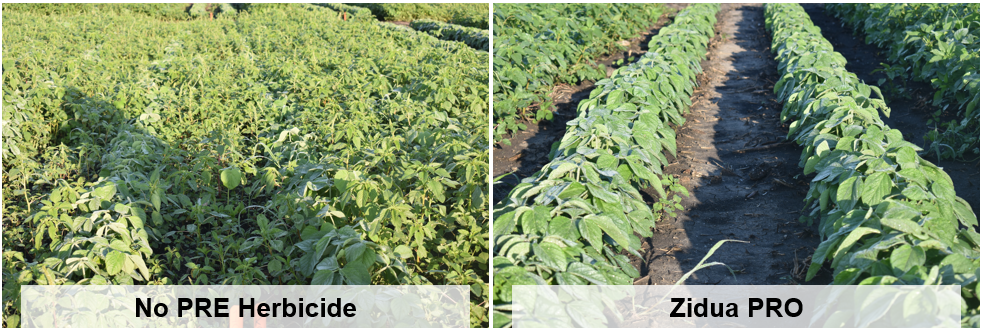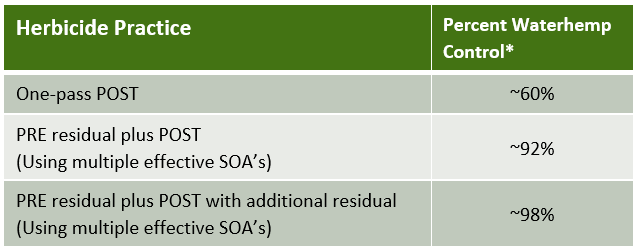ILSOYADVISOR POST
Considerations When Selecting From 3 Different Soybean Herbicide Trait Platforms

As we move closer to the 2020 growing season, one key decision that Illinois growers are making is which soybean herbicide trait platform to use on their farm. In addition to non-GMO options, there are currently three primary systems from which to choose: LibertyLink® GT27, Roundup Ready 2 Xtend® and Enlist E3® soybeans. When used correctly, all of these platforms can lead to effective and successful weed control. However, they all come with unique considerations that must be kept in mind when planning a weed control program.
Regardless of which trait platform is chosen, weed control should start with a quality pre-plant/pre-emergence (PRE) residual herbicide with multiple effective sites of actions (SOAs). The majority of soybean PRE herbicides are flexible across all traits, so growers should make their herbicide selection based on the length of residual control and effectiveness on the weed species present in their fields. The use of a quality PRE residual herbicide will not only control a large percentage of the weeds in the field before they emerge, but it will also provide risk management and flexibility for a timely post-emerge herbicide application. The easiest weed to control is one that hasn’t yet emerged!

Zidua PRO® was applied prior to soybean emergence at a rate of 6 fl oz per acre.
Trait Systems:
LibertyLink GT27: These soybeans are tolerant to glufosinate (e.g., Liberty®), glyphosate and isoxaflutole. The combination of Liberty and glyphosate is an effective option for growers, as Liberty will provide contact control of broadleaf weed species (including waterhemp) and grasses. Tank-mixing glyphosate with Liberty will bring additional control of many grass species and provide an additional SOA on several broadleaf species. If utilizing this combination, use a carrier volume and nozzle tips that will provide sufficient coverage for both products to be effective. Consult your equipment manufacturer and product labels for any questions.
Currently, there are no documented cases of weeds resistant to Liberty in Illinois. Because Liberty is a contact herbicide, adequate coverage is key for successful weed control. Target weeds at a height of three inches or less. Also remember to calibrate your sprayer to optimize coverage by using a minimum of 20 gallons per acre carrier volume, proper spray nozzles and appropriate operating pressures.
Roundup Ready 2 Xtend: These soybeans are tolerant to dicamba and glyphosate, however only certain dicamba formulations are permitted for use with these soybeans. These approved formulations are: Engenia® (BASF), Xtendimax® with VaporGrip® Technology (Bayer), FeXapan® herbicide with VaporGrip Technology (Corteva), and Tavium® Plus VaporGrip Technology (Syngenta). Dicamba provides control of a wide range of broadleaf weeds, however dicamba alone will not control grass weeds. Including an approved glyphosate product in these applications will provide control of grasses and aid in control of many broadleaf weeds.
Because dicamba is a systemic herbicide, it takes less coverage to obtain weed control as compared to contact herbicides. Therefore, applications of dicamba should be focused on preventing off-target movement onto a sensitive crop or area. These dicamba formulations have additional label requirements including approved nozzles and tank mixtures, additional application parameters defining weather and surrounding areas, and procedures for spray system hygiene.
Users need to consult the specific product label for all restrictions and follow all federal and state label requirements. That being said, when label requirements are followed, successful applications can occur providing quality weed control.
Enlist E3 Soybeans: These soybeans are tolerant to 2,4-D, glufosinate, and glyphosate. Not all brands of 2,4-D are available for use on these soybeans. The only 2,4-D formulations allowed for use on these soybeans are Enlist One® Herbicide with Colex D Technology and Enlist Duo® Herbicide with Colex D Technology. 2,4-D also has many similarities to dicamba, including the same SOA, systemic control of broadleaf weeds, and lack of grass control. 2,4-D and glufosinate give Enlist E3 growers the unique ability to use two effective options for control of emerged glyphosate- and PPO-resistant waterhemp after the soybeans have emerged.
BASF and Corteva are both promoting the tank-mixture of Enlist One and Liberty in order to use two effective SOAs on waterhemp and other weeds while improving the consistency of control of both products. When applying this tank-mix, growers should still strive to optimize coverage for Liberty while also following the application requirements of Enlist One.
Enlist One and Enlist Duo also have additional application requirements. These include approved tank-mix partners, nozzles, and awareness of downwind sensitive crops and areas. Again, when label requirements are followed, successful applications will result in quality weed control programs. Also remember that Liberty alone is an effective option in Enlist E3 soybeans, even in situations where the use of Enlist One or Enlist Duo is not suitable.

No matter which soybean herbicide trait system is chosen, a post-emergence residual herbicide should also be included in order to overlap residuals in soybeans. This will provide consistent residual control of weeds throughout the growing season. Remember, the easiest weed to control is one that never emerges. Because many residual herbicides used in post-emerge soybeans do not have foliar activity, they should be tank-mixed with complementary herbicides to control emerged weeds. Effective post-emergence residual options include pyroxasulfone (e.g., Zidua®; BASF), dimethenamid-P (e.g., Outlook®; BASF), acetochlor (e.g., Warrant®; Bayer) and s-metolachlor (e.g., Dual II Magnum®; Syngenta). Always consult the specific product label for approved tank-mix options.
While the prospect of choosing a soybean herbicide trait platform may seem difficult, Illinois farmers can be assured that quality weed control can be achieved with all three systems. Therefore, the choice of which soybean to plant should be based around yield potential and the ability to responsibly steward the herbicide products to be used.
LibertyLink, Liberty, Engenia, Outlook, and Zidua are registered trademarks of BASF.
Roundup Ready 2 Xtend, Xtendimax, VaporGrip, and Warrant are registered trademarks of Monsanto Technology LLC.
Enlist, Enlist One, and Enlist Duo are registered trademarks of Dow Chemical Company.
Tavium and Dual II Magnum are registered trademarks of a Syngenta Group Company.





Comments
Add new comment